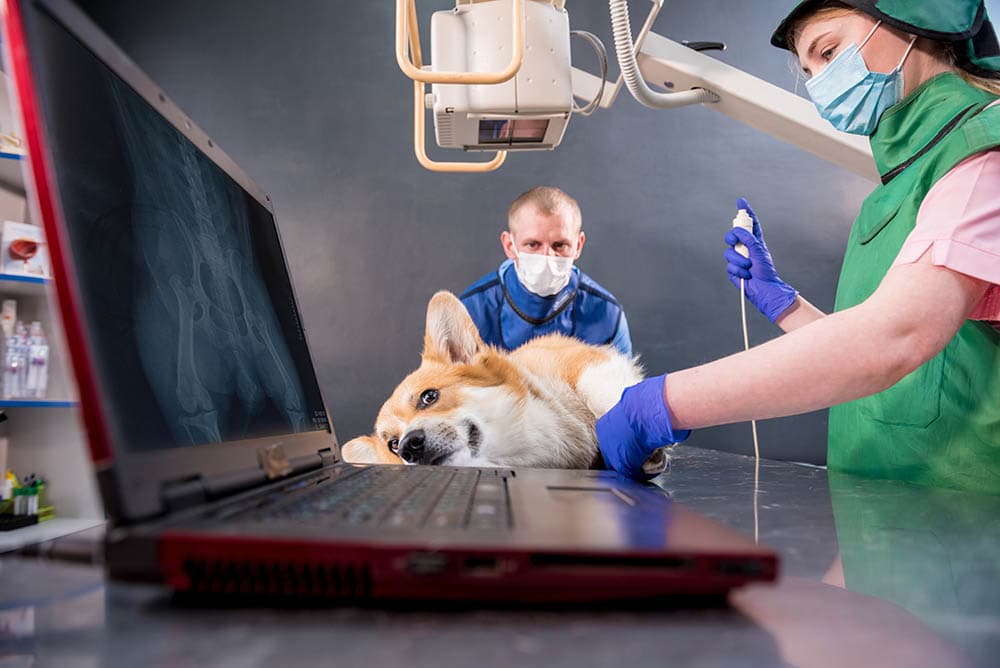Neuropathy in Dogs: Common Signs to Look Out For (Vet Answer)

Updated on

Click to Skip Ahead
Peripheral neuropathy is a neurological condition that occurs as a result of injuries produced at the level of peripheral nerves. This condition has complex clinical signs that differ from one dog to another. Peripheral neuropathy usually causes muscle weakness, numbness, and pain.
It is a result of trauma or disease that affects the nerves or their function or the condition of the spine. In peripheral neuropathy, it is difficult to recognize the center of pain, especially in dogs that do not respond to certain stimuli.
In this article, you will learn what canine neuropathy is, the causes and clinical signs, and how you can help your dog if they are suffering from this condition.
What Is Canine Neuropathy?
Canine neuropathy is a disease that causes disorders in your dog’s peripheral nervous system, which is composed of a network of nerves that connects to the central nervous system and is spread throughout your pet’s body. Peripheral nerves are mainly responsible for your dog’s digestion, coordination, and physical responses.
These nerves are not protected by bones, as is the case with the central nervous system, but are sheathed by myelin, an insulating lipid material. This disease sets in when the myelin sheath is damaged, affecting the transmitting capabilities of the nerves and your dog’s motor skills.

What Are the Signs of Canine Neuropathy?
Dogs suffering from neuropathy experience continued chronic pain, usually triggered by the slightest touch of the affected area. The pain that originates in the spinal cord causes mobility problems for dogs and dysregulation of body functions, such as urinary incontinence.
The most common clinical signs of canine neuropathy include:
- Lameness
- Dogs dragging their limbs
- Vocalizations
- Lack of appetite
- Affected areas being painful
- Biting and chewing of the affected areas
- Twitching of the skin
- Muscle atrophy
- Incoordination
- Urinating and defecating inappropriately (incontinence)
Clinical signs vary from case to case, depending on the affected segment. Polyneuropathy can be:
- Sensory neuropathy: when the nerves responsible for sensations are affected
- Motor neuropathy: when the nerves responsible for movement are affected
- Sensorimotor neuropathy: when both types of nerves are affected
The disease can also affect the autonomic nerves responsible for controlling functions like digestion, bladder, blood pressure, and heart rate. Therefore, canine neuropathy can cause different types of degeneration. For example, when it comes to motor impairment, the affected dog may show the following clinical signs:
- Muscle spasms
- Atrophy
- Weak reflexes
- Paralysis in all four limbs
If your dog suffers from disorders of the sensory nerves, they can lose their ability to orient themselves in space and lose consciousness. When it comes to the autonomic nervous system, affected dogs will have urinary incontinence, lack of anal reflex, or a slower heart rate.
What Are the Causes of Canine Neuropathy?
- Toxins (industrial chemicals, pesticides, herbicides, etc.)
- Injuries and trauma
- Nutritional deficiencies (vitamin B12 and E deficiency)
- Arthritis
- Metabolic diseases (diabetes, hypothyroidism, etc.)
- Cancer
- Degenerative disorders
- Blood vessel disorders
- Inflammatory disorders

1. Toxins
Signs of acute poisoning with industrial chemicals, pesticides, or herbicides include:
- Vomiting
- Diarrhea
- Excessive salivation
- Breathing difficulties
- Muscle tremors
- Seizures
- Coma
In the intermediate forms, dogs can present clinical signs that are not so obvious. As time passes, intoxicated animals will show the following signs:
- Partial paralysis of the legs and weakness of the neck (appear within a few days of intoxication)
- Dilated pupils
2. Metabolic Diseases
Diabetes Mellitus
In dogs with diabetes, neuropathy is less common. However, dogs suffering from diabetic neuropathy may show the following clinical signs:
- Stumbling often
- Stiffness
- Difficulty lying down
- Incoordination
- Muscular atrophy
- General weakness
- Paralysis of the hind limbs
Hypothyroidism
Cases of long-term, untreated hypothyroidism can lead to hypothyroid neuropathy. Large-breed dogs are the most prone and can present the following clinical signs:
- Postural reaction deficits
- Hyporeflexia (decreased or absent reflex response)
- Hypotonia (decreased muscle tone)
- Muscle atrophy
- Loss of balance
- Laryngeal paralysis
- Regurgitation

3. Degenerative Disorders
Degenerative diseases are represented by:
- Intervertebral disc disease
- Dancing Doberman disease
- Distal polyneuropathy of Rottweilers
- Idiopathic facial paralysis
- Acquired laryngeal paralysis
Intervertebral Disc Disease (IVDD)
IVDD is mainly a hereditary disease, but it can also occur due to environmental and lifestyle factors. This condition occurs when the intervertebral discs dry out, leading to swelling, ruptures, and herniation of the spinal cord. Clinical signs include:
- Keeping the head down
- Arched back
- Tremors
- Muscle spasms
- Stiff neck and limbs
- Paralysis
Dancing Doberman Disease
This neuromuscular disease affects Doberman Pinschers aged over 6 months. Clinical signs at the onset of the disease are represented by repeated flexion of the hip and extension of a hind limb while the dog is standing.
As the condition progresses, the clinical signs modify; affected dogs will alternately flex and extend both of their hind limbs (it will seem like the dog is dancing). This condition has no treatment, and in time, it will lead to mild partial paralysis.

Distal Polyneuropathy of Rottweilers
This degenerative disorder affects all four legs of Rottweiler dogs aged between 2 and 4 years. Affected dogs will show the following clinical signs:
- Reduced reflexes
- Muscle loss
- Muscle weakness
Idiopathic Facial Paralysis
Idiopathic facial paralysis is a condition that occurs mainly in Boxers, English Setters, Pembroke Welsh Corgis, and Cocker Spaniels. This disorder leads to weakness or paralysis of the facial muscles. Clinical signs appear suddenly and include:
- Inability to blink with one or both eyes
- Dropped ears
- Upper lip drooping
- Salivation
Acquired Laryngeal Paralysis
This occurs in middle-aged and older large breeds. The most prone are Labrador Retrievers, Golden Retrievers, and Saint Bernards. As the name suggests, this condition leads to the paralysis of one or more cartilages of the larynx. In severe cases, dogs can show:
- Breathing difficulties
- Blue tongue and gums
- Refusal to walk or move
- Dry, noisy cough
- Neurological signs (weakness and decreased sense of position)

4. Blood Vessel Disorders
Ischemic mononeuropathy occurs when the blood flow to nerves and muscles is blocked due to blood clots. Dogs suffering from heart disease, kidney disease, Cushing’s disease, cancer, or hypothyroidism are more prone. Clinical signs include:
- Sudden weakness of the limbs (the hind limbs are the most affected)
- Pain
- Paralysis
5. Inflammatory Disorders
Inflammatory diseases that can cause neuropathy in dogs are represented by:
- Acquired myasthenia gravis: This causes stiffness, tremor, weakness, swallowing difficulties, regurgitation, and pneumonia (in severe cases). The severe form, fulminant myasthenia gravis, can lead to sudden paralysis, respiratory paralysis, and death.
- Acute idiopathic polyradiculoneuritis: It usually occurs from a raccoon bite (also called Coonhound paralysis), but not all affected dogs have been bitten by raccoons. Clinical signs include partial or total paralysis of the limbs and weakness of the face and neck.
- Chronic inflammatory demyelinating polyneuropathy: This condition gradually leads to limb weakness and decreased reflexes.
- Trigeminal neuritis: Since the trigeminal nerve becomes inflamed and damaged, the affected dogs will present a sudden paralysis of the jaw (they will not be able to eat, swallow, and close their mouth).
How Do I Care for a Dog With Neuropathy?
Since neuropathy has multiple causes, the veterinarian must first determine the cause that led to the occurrence of this condition. Depending on their diagnosis, they will also give you recommendations for at-home care.
Follow the veterinarian’s instructions and the prescribed treatment, and try to make your dog’s life as pleasant and easy as possible. It is also possible for the vet to prescribe analgesic and anti-inflammatory drugs for your dog’s chronic pain.

 FAQs on Neuropathy in Dogs
FAQs on Neuropathy in Dogs
How Do You Treat Neuropathy in Dogs?
The treatment of neuropathy consists mainly of the administration of analgesic drugs to reduce pain, such as gabapentin, and/or anti-inflammatory drugs (prednisone). However, the primary cause that led to the occurrence of the neuropathy must be addressed and treated.
Does Neuropathy in Dogs Go Away?
Your dog’s recovery will depend on the underlying condition. For example, if your dog suffers from diabetes, the disease will have to be kept under control with medication so diabetic neuropathy does not occur again. Most diseases that lead to neuropathy in dogs must be treated and monitored for life. As long as you keep the primary condition under control, the less likely that your dog will develop peripheral neuropathy.
Additional Information
Conclusion
Neuropathy in dogs has multiple causes, most of the time occurring as an effect of a primary disease. If your dog shows lameness, drags their limbs, or has skin twitches and chronic pain, they may suffer from neuropathy. In this case, it is crucial to diagnose and treat the primary condition. Also, to relieve the pain, the veterinarian will prescribe your dog anti-pain and anti-inflammatory medication.
Featured Image Credit: invisible invisible, Shutterstock



 FAQs on Neuropathy in Dogs
FAQs on Neuropathy in Dogs









